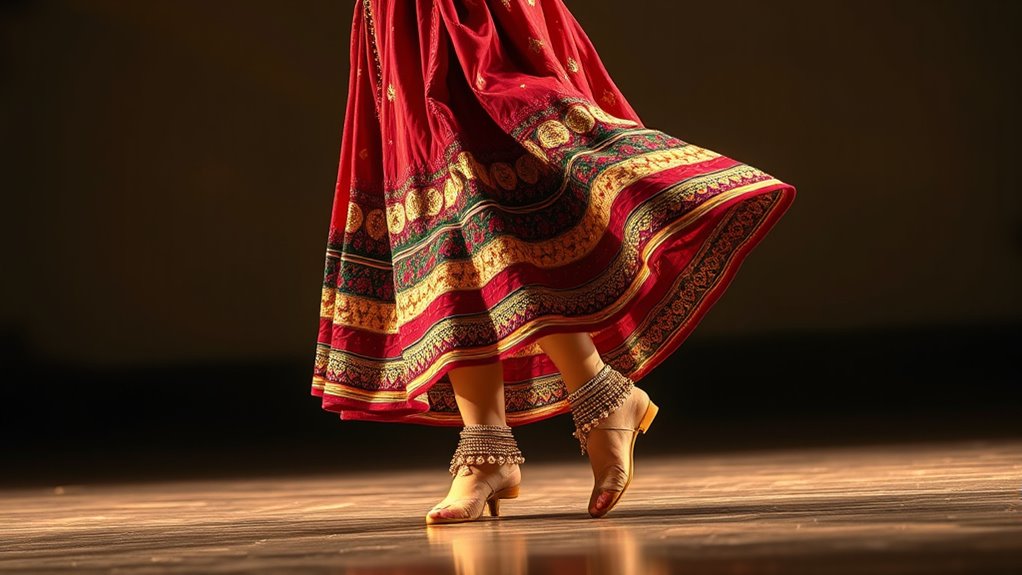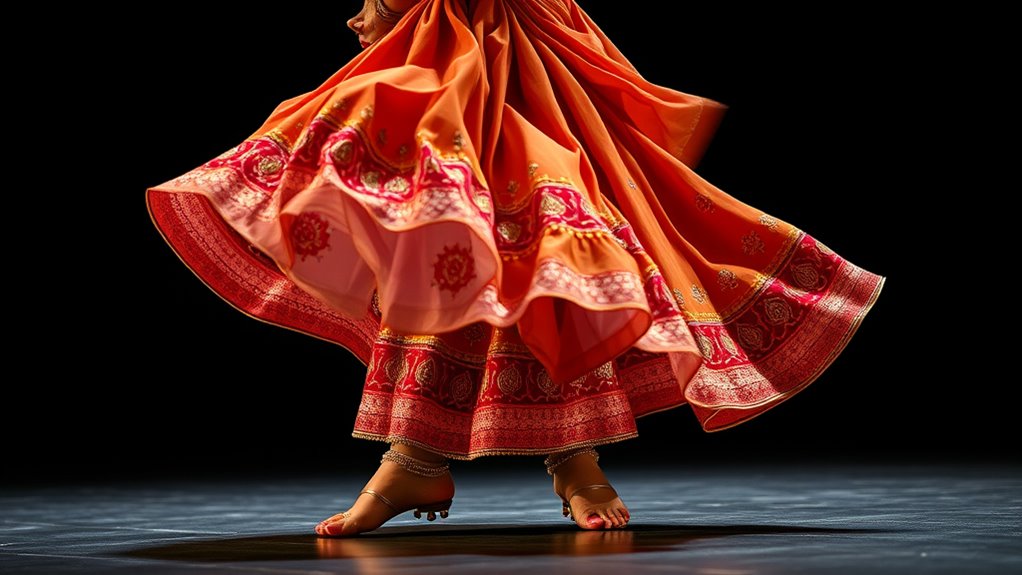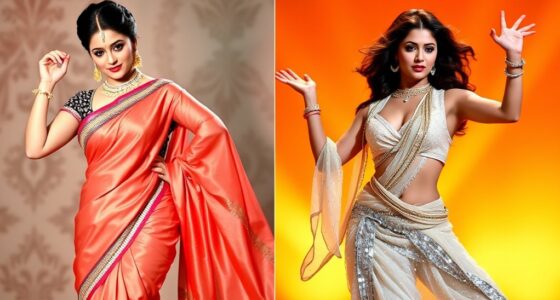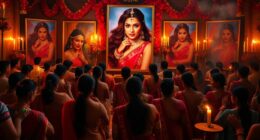In “Devdas,” Kathak steps showcase a blend of rhythmic footwork, intricate spins called “chakkars,” and expressive gestures called “mudras” that tell a story without words. You’ll notice precise timing, rapid “tatkar” steps, and graceful movements that highlight the dance’s cultural depth. These steps reflect centuries of tradition, combining spirituality with artistry. If you continue exploring, you’ll discover the secrets behind each movement and how they create a captivating narrative.
Key Takeaways
- Kathak steps like “tatkar” are rapid, intricate footwork that create rhythmic patterns synchronized with music.
- Spins or “chakkars” involve controlled, graceful rotations emphasizing balance and storytelling.
- Hand gestures or “mudras” in “Devdas” visually depict emotions and narrative elements without words.
- Footwork sequences combine precise timing and rhythm, showcasing technical mastery and enhancing expression.
- The dance integrates spins, footwork, and gestures seamlessly, highlighting Kathak’s expressive storytelling in the film.

In the film “Devdas,” the intricate Kathak dance sequences stand out as a highlight, showcasing the classical Indian dance form’s grace and storytelling power. If you’re new to Kathak, understanding its history context can deepen your appreciation. Kathak’s origins trace back over a thousand years to northern India, where it evolved from temple dances performed to honor deities and later became a court dance for Mughal emperors. This rich history blends spirituality with artistry, and its development reflects centuries of cultural exchange, making it a vibrant expression of Indian heritage. When you observe the dance technique in “Devdas,” you see this history alive in every movement. Kathak’s distinctive technique involves precise footwork, intricate spins, and expressive gestures called “mudras.” These gestures aren’t just decorative; they narrate stories, emotions, and legends, making every dance a visual storytelling session. The dance’s hallmark is its rhythmic footwork, where you’ll notice rapid, small steps like “tatkar,” which are executed with remarkable speed and accuracy, often synchronized with complex musical compositions. These foot movements create a mesmerizing percussive sound, acting as a bridge between music and storytelling. The spins, or “chakkars,” are another signature element, showcasing the dancer’s control and grace as they whirl in perfect circles, symbolizing spiritual transcendence and divine energy. As you watch the dancers in “Devdas,” you’ll see these technical elements masterfully combined to evoke emotion and narrative. The hand gestures or “mudras” serve as a language, expressing love, longing, despair, or joy without words. Every gesture is deliberate, conveying meaning and enhancing the story told through dance. The dancers’ posture and facial expressions further amplify this storytelling, making the performance immersive. The choreography in “Devdas” captures the essence of traditional Kathak while also adapting it for cinematic storytelling. You can appreciate how the dance technique demands rigorous discipline—each step, spin, and gesture must be executed with precision to maintain rhythm and expressivity. Kathak’s history context enriches your understanding of its dance technique, revealing how centuries of cultural influences shape every movement you see. The seamless integration of technical mastery and storytelling in “Devdas” highlights why Kathak remains an expressive and essential art form. Watching these sequences, you’re witnessing a dance tradition that has survived centuries, evolving yet retaining its core essence—storytelling through rhythm, movement, and emotion.
Frequently Asked Questions
How Do Kathak Steps in “Devdas” Differ From Traditional Performances?
You notice that the Kathak steps in “Devdas” differ from traditional performances because they blend classical dance with fusion choreography, making them more accessible and visually dramatic. In this cinematic adaptation, the choreography emphasizes expressive storytelling and emotional intensity, often simplifying complex footwork for cinematic effect. This approach enhances the narrative, making Kathak feel contemporary and mesmerizing, unlike traditional performances that focus more on intricate, disciplined movements.
Are Specific Kathak Skills Required to Perform These Steps?
You need solid Kathak technique and dance proficiency to perform these steps confidently. The choreography in “Devdas” demands precise footwork, intricate spins, and expressive gestures, all of which require dedicated practice. Mastering these skills allows you to execute the steps smoothly and authentically. Without strong Kathak technique, it’s challenging to capture the dance’s grace and energy, making consistent training essential for performing such complex sequences convincingly.
What Is the Significance of the Footwork in “Devdas”?
You see, the footwork in “Devdas” is essential because it enriches the dance symbolism and expresses emotion through rhythmic patterns. Your precise steps highlight the narrative’s mood and character feelings. Combined with expressive gestures, the footwork guides viewers into the story’s depth, making each movement meaningful. It’s not just technique but a language that conveys love, despair, and hope, elevating the dance’s emotional impact.
How Authentic Are These Kathak Steps Compared to Classical Performances?
You might wonder about the dance authenticity in “Devdas” compared to classical performances. The Kathak steps are generally well-choreographed, respecting traditional movements, but they’re adapted for cinematic storytelling. While they capture the essence of Kathak, some nuances might be simplified for visual impact. Overall, the film maintains cultural accuracy, showcasing the beauty of Kathak, though it may not fully reflect the depth of a live, classical performance.
Who Choreographed the Kathak Sequences in “Devdas”?
You might be surprised to learn that the choreographer credits for “Devdas” highlight an artistic interpretation rather than strict classical adherence. The sequences were crafted by a team blending traditional Kathak with cinematic flair, making them visually stunning. This creative approach offers a fresh perspective for viewers, showing how choreography can enhance storytelling. So, while not purely classical, the choreography captures the essence of Kathak through a unique artistic lens.
Conclusion
So, next time you watch “Devdas,” watch those Kathak steps and realize you’re witnessing centuries of dance magic in action. It’s as if the dancers summon the entire universe’s rhythm and soul with every movement, turning a simple performance into an epic saga of grace and passion. You’ll never see Kathak the same way again—you’ll feel like you’re standing at the edge of eternity, witnessing history’s most mesmerizing dance unfold before your eyes!









